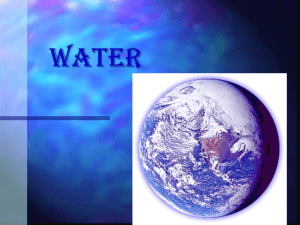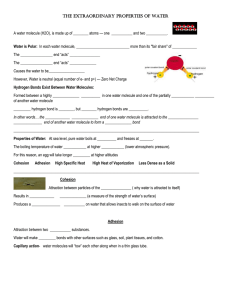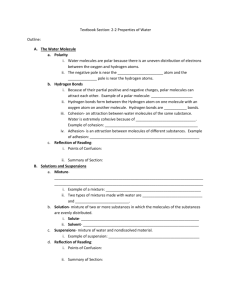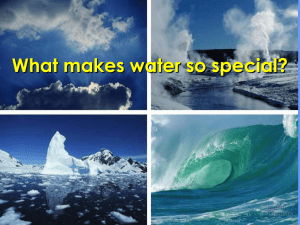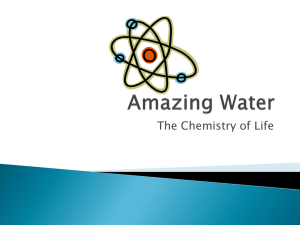The Extraordinary Properties of Water
advertisement
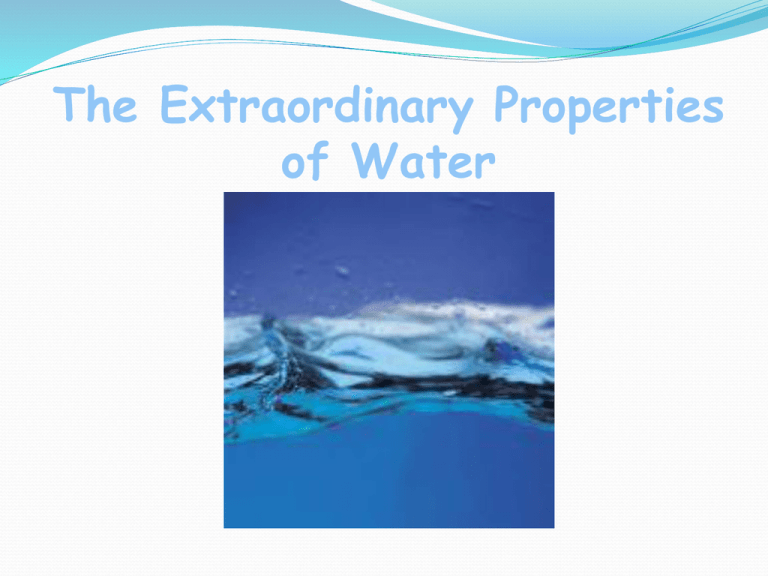
The Extraordinary Properties of Water Water A water molecule (H2O), is made up of three atoms --- one oxygen and two hydrogen. The bonds between the atoms are polar covalent bonds. H O H Water is Polar The oxygen end has a slight negative charge The hydrogen end has a slight positive charge The positive and negative charges attract each other. Water is Polar In each water molecule, the oxygen atom attracts more than its "fair share" of electrons. The oxygen atom is more electronegative than the hydrogen atoms. This symbol indicates electronegativity. The Oxygen atom has a slight negative charge. Water is Polar This is what causes the water to be POLAR However, water is neutral (equal number of e- and p+) --- Zero Net Charge Hydrogen Bonds Exist Between Water Molecules Hydrogen bonds are temporary bonds formed between a highly electronegative atom of a polar molecule and a Hydrogen atom of another molecule. One hydrogen bond is weak, but many hydrogen bonds are strong Interaction Between Water Molecules H O The negative Oxygen end of one water molecule is attracted to the positive Hydrogen end of another water molecule to form a HYDROGEN BOND Interaction Between Water Molecules O Each hydrogen atom in one water molecule forms a single hydrogen bond with each oxygen atom of another water molecule. Interaction Between Water Molecules Each oxygen atom in one water molecule forms two hydrogen bonds with two hydrogen atoms from two other water molecules. Interaction Between Water Molecules As a result, each water molecule can form as many as four hydrogen bonds with four other water molecules. This leads to unique properties of water that are necessary for life on Earth. What are the Properties of Water? Properties of Water At sea level, pure water boils at 100 °C and freezes at 0 °C. The boiling temperature of water decreases at higher elevations (lower atmospheric pressure). For this reason, an egg will take longer to boil at higher altitudes Properties of Water Cohesion Properties of Water Cohesion- water molecules stick to each other This results in surface tension (a measure of the strength of water’s surface) This in turn produces a surface film that allows some insects to walk across water. Cohesion … Helps insects walk across water Properties of Water Cohesion Adhesion Adhesion • Attraction between two different substances. • Water will make hydrogen bonds with other surfaces such as glass, soil, plant tissues, and cotton. Capillary action-water molecules will “tow” each other along when in a thin glass tube. Example: transpiration process which plants and trees remove water from the soil, and paper towels soak up water. Adhesion Causes Capillary Action Which gives water the ability to “climb” structures. Adhesion Also Causes Water to … Hold onto plant leaves Note: the “spheres” formed in both photos are the result of cohesion Attach to a silken spider web Properties of Water Cohesion Adhesion High Specific Heat High Specific Heat • Specific heat - amount of heat needed to raise or lower 1g of a substance 1° C. Water resists temperature change, both for heating and cooling. Water can absorb or release large amounts of heat energy with little change in actual temperature. Properties of Water Cohesion Adhesion High Specific Heat High heat of vaporization High Heat of Vaporization Amount of energy to convert 1g or a substance from a liquid to a gas In order for water to evaporate, hydrogen bonds must be broken. As water evaporates, it removes a lot of heat with it. High Heat of Vaporization Water's heat of vaporization is 540 cal/g. In order for water to evaporate, each gram must GAIN 540 calories (temperature doesn’t change --- 100oC). As water evaporates, it removes a lot of heat with it (cooling effect). Properties of Water Cohesion Adhesion High Specific Heat High heat of vaporization Less dense as a solid Water is Less Dense as a Solid • Ice is less dense as a solid than as a liquid (ice floats) • Liquid water has hydrogen bonds that are constantly being broken and reformed. • Frozen water forms a crystal-like lattice whereby molecules are set at fixed distances. Water is Less Dense as a Solid •Which is ice and which is water? Water is Less Dense as a Solid •Which is ice and which is water? water ice Water vapor forms a kind of global ‘‘blanket” which helps to keep the Earth warm. Heat radiated from the sun warmed surface of the earth is absorbed and held by the vapor. Homeostasis Ability to maintain a steady state despite changing conditions Water is important to this process because: a. It makes a good insulator b. It resists temperature change c. It is a versatile solvent d. It acts as a coolant e. Ice protects against temperature extremes (insulates frozen lakes) Works Cited: http://wps.aw.com/bc_campbell_biology_7/25/6654/1 703570.cw/index.html

